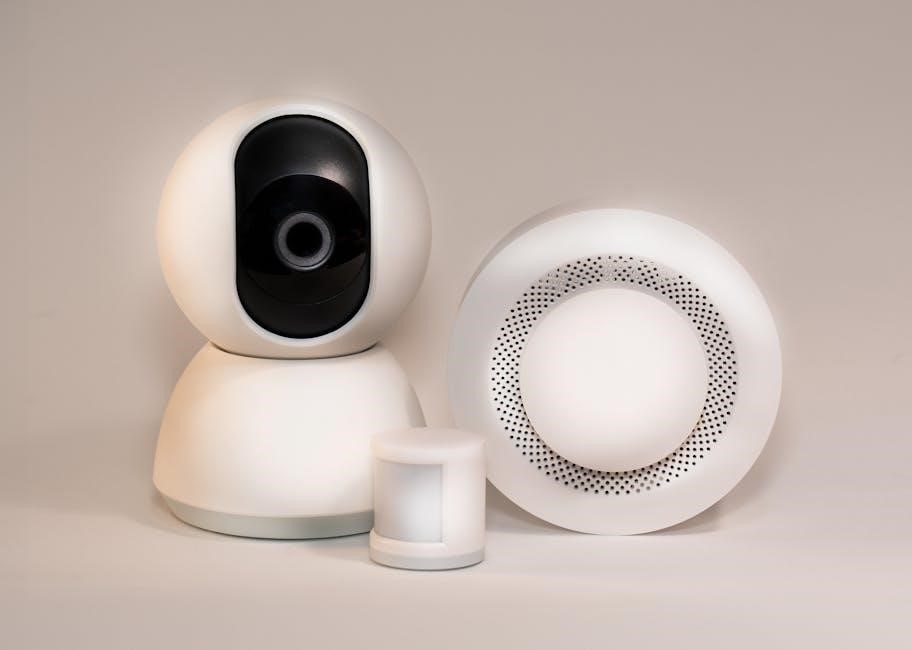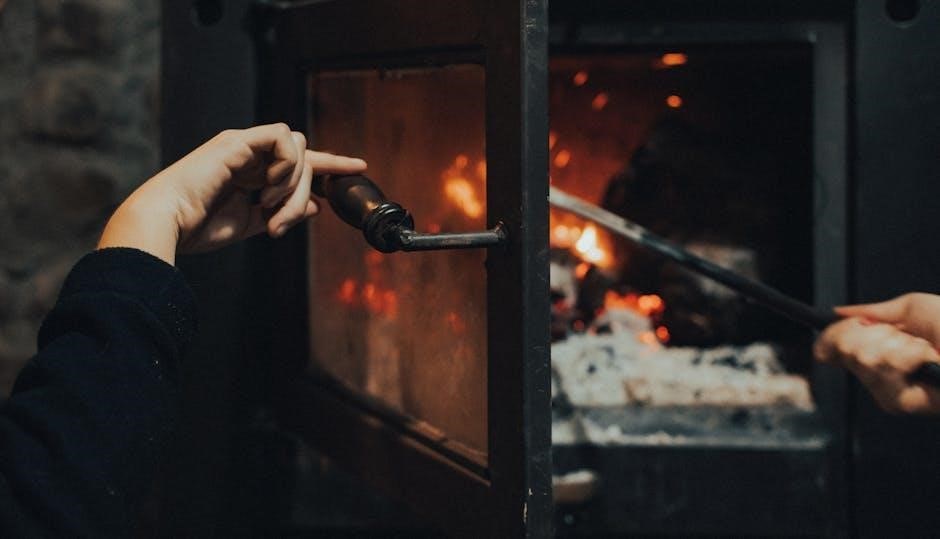Welcome to the Kidde Smoke and Carbon Monoxide Alarm manual․ This guide provides essential information for installing, operating, and maintaining your Kidde Smoke/CO Alarm; Designed to detect both smoke and carbon monoxide, this device ensures comprehensive protection for your home․ Refer to this manual for troubleshooting, features like interconnectivity, and Hush Control․ For assistance, call our Product Support Line at 1-800-880-6788․
Overview of the Kidde Smoke/CO Alarm System
The Kidde Smoke/CO Alarm System is a comprehensive safety solution designed to detect both smoke and carbon monoxide in residential environments․ It features advanced detection technologies, including a voice message system and peak level memory, to provide clear alerts and track hazard levels․ The system is interconnectable with other Kidde devices, enabling whole-home protection․ Its user-friendly design ensures reliable performance and ease of maintenance for optimal safety․
Importance of Smoke and Carbon Monoxide Detection
Smoke and carbon monoxide detection are critical for protecting lives and property․ Smoke alarms detect fires early, providing crucial escape time, while CO detectors identify odorless, deadly gas leaks․ Both threats can escalate rapidly, making reliable detection essential․ The Kidde system integrates these safeguards, offering a layered defense against silent killers like CO and unpredictable fires, ensuring a safer living environment for families․
Key Features of the Kidde Smoke and CO Alarm
The Kidde Smoke and CO Alarm features interconnectivity, Hush Control, Peak Level Memory, and a voice message system for clear alerts․ Its LED display and battery backup ensure reliable performance and user convenience․
Interconnectivity with Other Kidde Devices
The Kidde Smoke/CO Alarm can interconnect with up to 24 Kidde devices, including smoke, heat, and carbon monoxide alarms․ This feature ensures all alarms sound when one detects smoke or CO, providing whole-home protection․ Compatible with Kidde, Nighthawk, and Fyrnetics products, the system allows for a unified response to potential threats․ Interconnectivity enhances safety by ensuring all areas of the home are alerted simultaneously․
Hush Control Feature for False Alarms
The Hush Control feature allows temporary silencing of false alarms caused by cooking or steam․ Pressing the Test/Reset button activates Hush mode, which mutes the alarm for 15 minutes․ The green LED flashes during this period․ Once Hush mode ends, the system announces “Hush Mode Cancelled” and resumes normal operation․ This feature ensures convenience while maintaining safety by addressing non-emergency situations without disabling the alarm entirely․
Peak Level Memory and Voice Message System
The Kidde Smoke/CO Alarm features a Peak Level Memory that stores the highest detected carbon monoxide levels, aiding in identifying potential hazards․ The voice message system provides clear alerts, such as “Carbon Monoxide Previously Detected” for CO levels above 100 ppm․ This advanced feature enhances safety by offering detailed notifications, ensuring users are informed and can take appropriate action․ The voice alerts are loud and clear, designed to be easily understood in emergency situations․

Installation Guidelines for the Kidde Smoke/CO Alarm
Install the Kidde Smoke/CO Alarm on every level of your home, including bedrooms, hallways, and basements․ Avoid areas near cooking appliances to minimize false alarms․ Use a UL-listed junction box for wiring and ensure all connections are made by a qualified electrician․ Follow NFPA 72 standards for optimal placement and safety․
Recommended Locations for Maximum Protection
For optimal safety, install the Kidde Smoke/CO Alarm on every level of your home, including inside each bedroom, hallways, and basements․ Place alarms at least 10 feet away from cooking appliances to reduce false alarms․ On sloped ceilings, install within 3 feet of the highest point․ Avoid areas near bathrooms or kitchens․ Ensure CO alarms are placed near sleeping areas to quickly alert occupants of potential dangers․
Step-by-Step Wiring and Mounting Instructions
First, ensure the power is off before starting․ Mount the bracket on a U․L․-listed junction box, following NFPA standards․ Connect the wires securely, adhering to local electrical codes․ Snap the alarm onto the bracket, ensuring it clicks․ Test the unit by pressing the test button․ For battery models, insert batteries as specified․ Replace the cover and verify all lights flash to confirm proper installation․ Always follow manufacturer guidelines for interconnectivity with other devices․
Understanding the Alarm Indicators and Alerts
The Kidde Smoke/CO Alarm features LED indicators and voice alerts․ The red LED flashes during smoke detection, while the green LED indicates standby mode․ Voice messages announce “Fire!” or “Carbon Monoxide!” for clear alerts․
LED Light Indications for Different Modes
The Kidde Smoke/CO Alarm uses LED lights to indicate its status․ A steady green LED signifies normal operation, while a flashing green LED indicates battery-only mode․ During smoke detection, the red LED flashes rapidly, and for carbon monoxide, it flashes with a slower pattern․ If an error occurs, the amber LED will flash, signaling issues like low battery or system faults․ Refer to the manual for detailed light sequences and troubleshooting guidance․
Voice Message Alerts for Smoke and CO Detection
The Kidde Smoke/CO Alarm features a voice message system that clearly announces “Fire!” or “Carbon Monoxide!” when detection occurs․ Additional messages include “Hush Mode Cancelled” and “Push Test Button” for maintenance reminders․ The voice alerts provide clear communication, ensuring quick response to emergencies․ This feature enhances safety by eliminating confusion and offering precise notifications for different threats in your home․
Operating and Maintaining the Alarm
Regularly test the alarm by pressing the test button, vacuum the cover monthly, and replace batteries annually․ Replace the entire unit every 10 years for optimal performance․
Testing the Alarm for Proper Functionality
Test your Kidde Smoke/CO Alarm weekly by pressing the test button to ensure it sounds and the LED lights function properly․ Use real smoke or approved test aerosols to verify detection accuracy․ Keep the alarm clean by vacuuming monthly to prevent dust buildup․ Replace batteries as needed and ensure the unit is replaced every 10 years for reliable performance․ Regular testing ensures your safety and compliance with standards․
Battery Replacement and Maintenance Tips
Replace batteries annually or when the alarm chirps, indicating low power․ Use approved brands like Duracell or Energizer․ For battery-backed models, remove the unit from the bracket, replace batteries, and reinstall promptly․ Clean vents and LED lights with a soft brush monthly․ Replace the entire unit every 10 years․ Always mark the replacement date on the side for easy tracking․ Proper maintenance ensures reliable protection and functionality․

Troubleshooting Common Issues
Address false alarms by using the Hush feature or checking for dust or cooking fumes․ Ensure proper installation and wiring․ Reset the alarm after CO detection by pressing the Test/Reset button․ Refer to the manual for error conditions and solutions to maintain optimal functionality and safety․ Always follow manufacturer guidelines for troubleshooting․
Addressing False Alarms and Error Conditions
False alarms can often be resolved by identifying the source, such as cooking fumes or steam․ Use the Hush feature to temporarily silence the alarm․ Ensure proper installation, check for dust or debris, and verify wiring connections․ If issues persist, consult the manual for error codes and solutions․ Regular maintenance, such as cleaning the sensor, can prevent recurring false alarms and ensure reliable performance․
Resetting the Alarm After CO Detection
After a CO detection, press and hold the Test/Reset button to silence the alarm․ If CO levels remain elevated, the alarm will sound again within 200 seconds․ Ensure the area is ventilated and the CO source is identified․ Once safe conditions are confirmed, the alarm will automatically reset․ Pressing the Test/Reset button again confirms the alarm is functioning correctly after the CO event․

Interconnectivity and Compatibility
Ensure seamless integration with compatible Kidde and Nighthawk devices, supporting up to 24 interconnected alarms for enhanced home safety and coordinated alerts across your network․
Connecting Multiple Alarms in a Home Network
Connect up to 24 Kidde Safety devices, including smoke, CO, and combination alarms, to create a unified home safety network․ This interconnectivity ensures all alarms sound when one detects smoke or CO, providing whole-home alerts․ Note that CO-only events will not trigger smoke alarms․ Always use compatible Kidde/Nighthawk products for reliable operation and adhere to NFPA interconnect limits for optimal performance and safety․
Compatibility with Other Kidde and Nighthawk Products
Your Kidde Smoke/CO Alarm seamlessly integrates with other Kidde and Nighthawk devices, ensuring a cohesive home safety system; It is compatible with smoke alarms like models 1235, 1275, and 1285, as well as heat alarms and relay modules․ For optimal performance, ensure all interconnected devices are Kidde or Nighthawk branded, as third-party products may not function correctly within the network․

Carbon Monoxide Safety and Emergency Procedures
Carbon monoxide (CO) is a colorless, odorless gas that can be deadly․ Common sources include faulty heating systems, generators, and fuel-burning appliances․ If your CO alarm sounds, immediately evacuate the premises, call emergency services, and stay outside until authorities confirm it’s safe to return․ Ensure your home has CO alarms on every level and near sleeping areas for early detection․
Understanding CO Risks and Sources
Carbon monoxide (CO) is a colorless, odorless gas produced by burning fossil fuels like gasoline, propane, natural gas, oil, and wood․ It can be fatal as it reduces blood’s ability to carry oxygen․ Common sources include faulty heating systems, generators, and fuel-burning appliances․ Poor ventilation in enclosed spaces can trap CO, leading to dangerous concentrations․ Understanding these risks is crucial for protecting your home and family from potential CO exposure․
Steps to Take When the CO Alarm Sounds
If the CO alarm sounds, act immediately․ Press the test/reset button to silence it if the condition persists․ Call your emergency services or fire department․ Evacuate everyone from the home, and stay outside․ Do not re-enter until authorities confirm it is safe․ Addressing CO risks promptly can prevent serious health consequences or fatal outcomes․
For optimal performance, refer to our support page for troubleshooting guides and manuals․ Call 1-800-880-6788 for expert assistance with your Kidde Smoke/CO Alarm․
Final Tips for Optimal Alarm Performance
Regularly test your Kidde Smoke/CO Alarm by pressing the test button to ensure functionality․ Replace batteries annually and vacuum the unit monthly․ Ensure interconnectivity with compatible devices․ Keep records of peak CO levels using the memory feature․ Never ignore alarms; act promptly․ For further assistance, visit our support page or call 1-800-880-6788․
